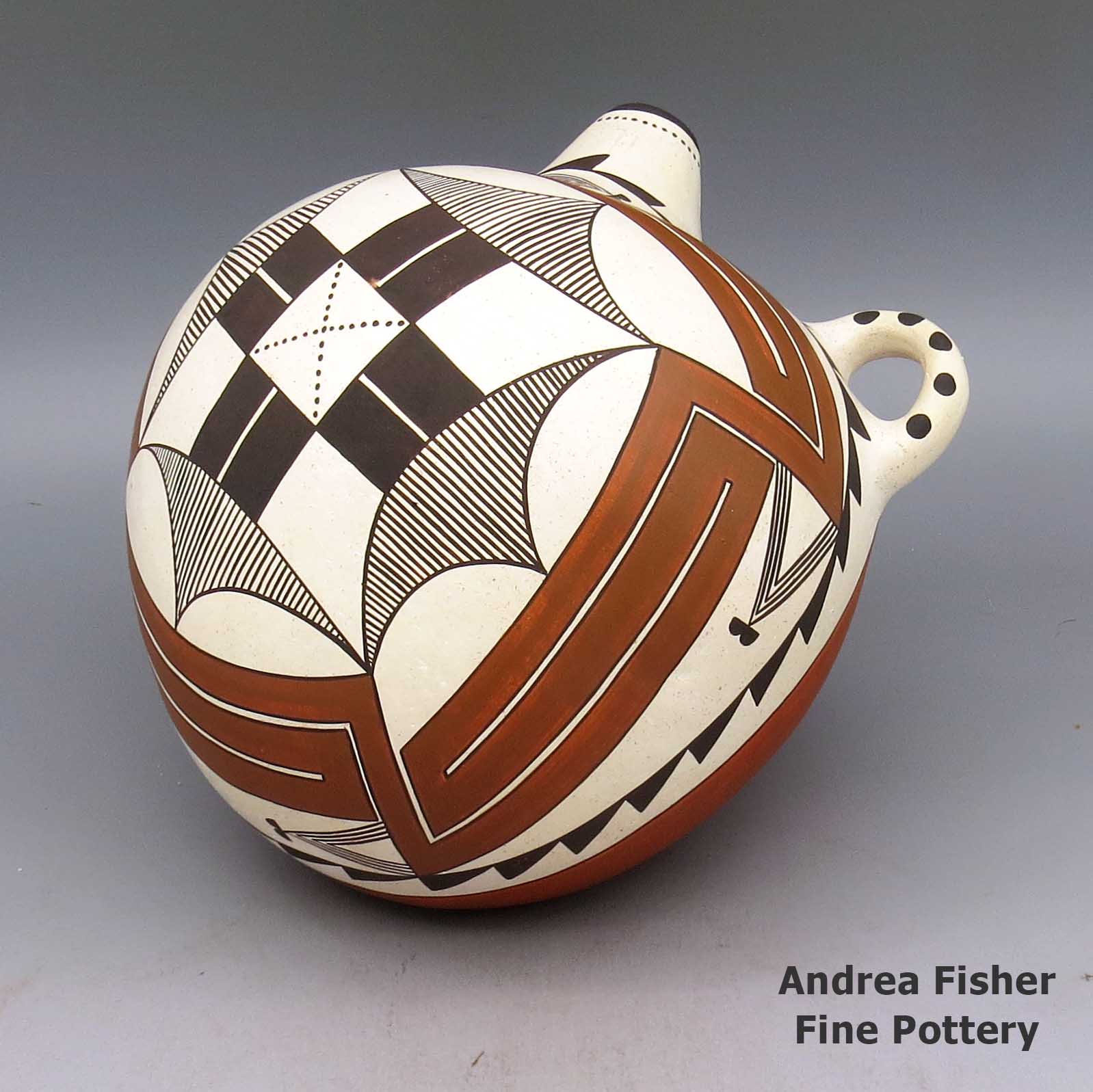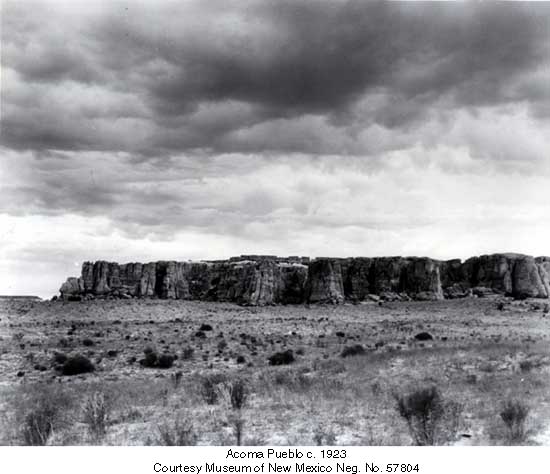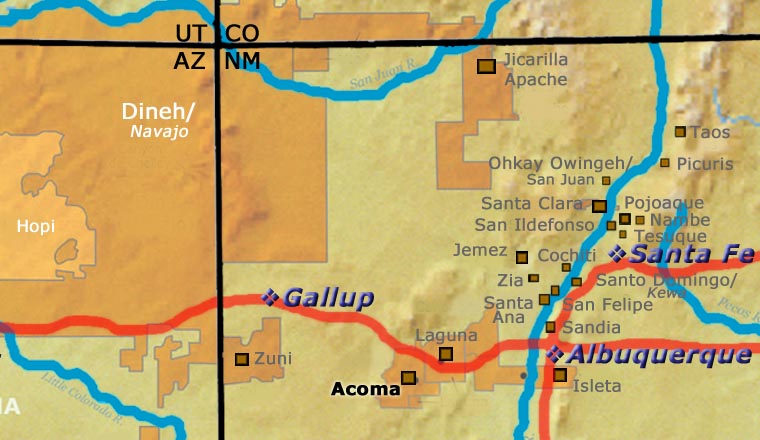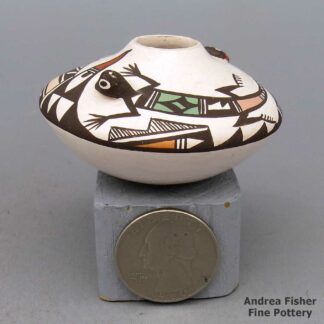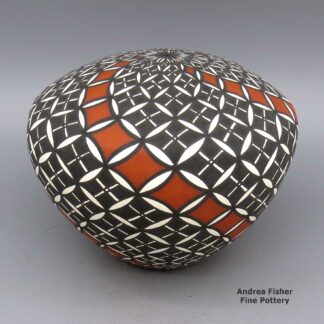| Dimensions | 8.25 × 8.75 × 7.5 in |
|---|---|
| Condition of Piece | Very good, some pitting |
| Date Born | 1994 |
| Signature | Dzinats’ituwits’a W. Aragon Acoma, NM, with raincloud hallmark |
Wanda Aragon, hwac2g291, Polychrome canteen with fine line and geometric design
$1,560.00
A polychrome canteen decorated with a fine line and geometric design, based on a design from around 1900
In stock
Brand
Aragon, Wanda
Wanda (Torivio) Aragon was born into Acoma Pueblo in November, 1948. Wanda and her older sister, Lilly Maria Salvador, learned how to make pottery through watching and working their mother, Frances Pino Torivio.
Wanda started making pottery for the marketplace around 1965. She made her first storyteller in the early 1970s. Over the years she made storage jars, wedding vases, bowls, owl figures, bird effigy pots, canteens, Nativities, miniatures and human figures. Her favorite designs were parrots, rainbows, deer-with-heart-lines, clouds and berry bushes.
Wanda participated in her first Santa Fe Indian Market in the early 1970s. In 1975, she started winning a long series of First, Second, Third, Honorable Mention, Best of Division and Best of Class ribbons everywhere from Santa Fe Indian Market to the Southwest Museum in Los Angeles to the Heard Museum in Phoenix to the Eiteljorg Museum in Indianapolis and the Lawrence Indian Arts Show in Lawrence, KS.
Wanda's work is on display at several museums around the world. She usually signs her pieces DZINATS'ITUWITS'A but sometimes she'll sign W. Aragon and sometimes she'll sign both.
A Short History of Acoma Pueblo

According to Acoma oral history, the sacred twins led their ancestors to "Ako." Ako turned out to be a magical mesa composed mostly of white rock. There the sacred twins instructed the ancestors to make that mesa their home. Acoma Pueblo is called "Sky City" because of its position atop the high mesa.
Acoma, Old Oraibi (at Hopi) and Taos all lay claim to being the oldest continuously inhabited community in the U.S. Those competing claims are hard to settle as each village can point to archaeological remnants close by to substantiate each village's claim. Acoma is located about 60 miles west of Albuquerque in a landscape littered with the ruins of ancient pueblos, many more than 1,000 years old.
The people of Acoma have an oral tradition that says they've been living in the same area for more than 2,000 years. Archaeologists feel more that the present pueblo was established near the end of the major migrations in the 1200 and 1300s. The location is essentially on the boundary between the Mogollon (Mimbres), Hohokam (Salado) and Anasazi (Ancestral Puebloan) cultures. Each of those cultures has had an impact on the styles and designs of Acoma pottery, especially since modern potters have been getting the inspiration for many of their designs from pot shards they have found while walking on pueblo lands.
Francisco Vasquez de Coronado ascended the cliff to visit Acoma in 1540. He afterward wrote that he "repented having gone up to the place." But the Spanish came back later and kept coming back.
Around 1598 relations between the Spanish and the Acomas took a nasty turn with the arrival of Don Juan de Oñaté and the soldiers, settlers and Franciscan monks that accompanied him. After making the arduous ascent to the mesa top, de Oñaté decided to force the Acomas to swear loyalty to the King of Spain and to the Pope. When the Acomas realized what the Spanish meant by that, a group of Acoma warriors attacked a group of Spanish soldiers and killed 11 of them, including one of de Oñaté's nephews.
De Oñaté retaliated by attacking the pueblo. His troops burned most of it and killed more than 600 people. Another 500 people were imprisoned by the Spanish. Males between the ages of 12 and 25 were sold into slavery. 24 men over the age of 25 had their right foot amputated. Many of the women over the age of 12 were also forced into slavery. Most were parceled out among Catholic convents in Mexico City.
Two Hopi men were also captured at Acoma. The Spanish cut one hand off of each and sent them home to spread the word about Spain's resolve to subjugate the inhabitants of Nuevo Mexico. Spanish monks did make the trip a few years later but Spanish military made hardly an appearance in Hopiland.
When word of the massacre (and the punishments meted out after) got back to King Philip in Spain, he banished Don Juan de Oñaté from Nuevo Mexico. Some Acomas had escaped that fateful Spanish attack and returned to the mesa top in 1599 to begin rebuilding.
In 1620 a Royal Decree was issued which established civil offices in each pueblo and Acoma got its first governor. That didn't help the people any as those appointed to the government positions were also those most on the take with the Spanish authorities. By 1680, the situation between all of the pueblos and the Spanish had deteriorated to the point where the Acomas were extremely willing participants in the 1680 Pueblo Revolt.
After the successful Pueblo Revolt pushed the Spanish back to Mexico, refugees from other pueblos began to arrive at Acoma. Most feared the eventual Spanish return and probable reprisals. That strained the resources of Acoma badly. Then the Spanish returned in force and residents of the pueblo had to make a hard decision. Many of the refugees chose to try a peaceful solution: they relocated north to the ancient Laguna area and made peace with the Spanish as soon as they reappeared in the region. Acoma held out against the Spanish for awhile but soon capitulated.
Over the next 200 years, Acoma suffered from breakouts of smallpox and other European diseases to which they had no immunity. At times they would side with the Spanish against nomadic raiders from the Ute, Apache and Comanche tribes. Eventually New Mexico changed hands. Then the railroads arrived and Acoma became dependent on goods made in the outside world.
For many years the villagers were content on the mesa. Now most live in villages on the valley floor where water, electricity and other necessities are easily available. A few families still make their permanent home on the mesa top. The old pueblo is used almost exclusively these days for ceremonial celebrations.
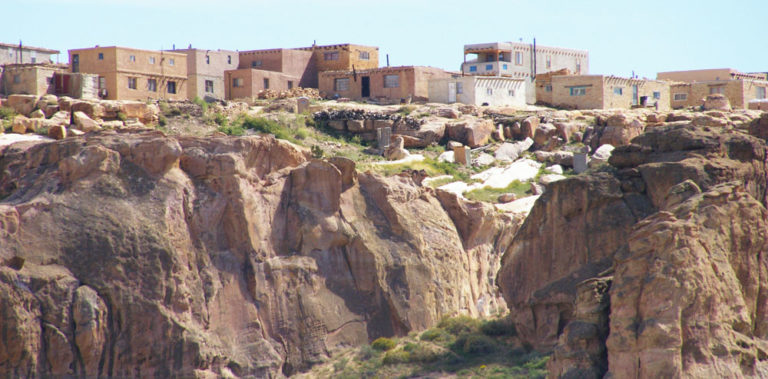
For more info:
Acoma Pueblo at Wikipedia
Pueblo of Acoma official website
Pueblos of the Rio Grande, Daniel Gibson, ISBN-13:978-1-887896-26-9, Rio Nuevo Publishers, © 2001
Acoma & Laguna Pottery, Rick Dillingham with Melinda Elliott, ISBN 0-933452-32-2, School of American Research Press, © 1992
Upper photo courtesy of Marshall Henrie, Creative Commons Attribution-Share Alike 3.0 Unported License
About Western Keresan Designs
Those of the Western Keres tradition have a plethora of traditional designs. A reason for that is they have occupied a region on the boundary between the Mogollon cultures to the south and the Ancestral Puebloan cultures to the north. And some of them have been living and working in the same place for a thousand years or more. They have also been making and breaking pottery the whole time. The area of Laguna has been more or less populated for a similar amount of time and, when populated, the Lagunas have moved around more than the Acomas.
Because Acoma and Laguna are located in that boundary area between Chaco Canyon influence to the north and Mogollon-Mimbres Valley influence to the south, designs and techniques have been coming and going across the landscape for many years. Over time, broken potsherds covered with multiple designs have fallen to the ground almost everywhere, just waiting to be picked up by someone, have their designs copied and revived, and their most basic constituents ground and mixed with fresh clay and to be reborn as pots again.
In the 1950s, that started happening a lot, potsherds being picked up and their designs revived, that is. Many of those designs have since been traced back to artisans in the Mimbres Valley working before 1150 CE. They had a unique perspective on the birds, animals, insects and people of their world, and used that perspective to draw and paint unique patterns. Many of those patterns are still being recreated on pottery across the Pueblo world, but especially at Acoma and Laguna. Central to the design palette are stories from the adventures of the Twin Warriors. While some Flower World iconography is also present in the Acoma design palette, there is extremely little from the kachina cults of the Hopi and Zuni.
One of the more recent "traditional" Acoma designs is the parrot holding a twig with berries in its claws. Often there is a rainbow above or below the parrot. Parrots are not natural in New Mexico, they had to have been imported. Before about 1450 CE, there was a trade in parrots and macaws through Paquimé to regions in the north. The remains of macaws have been pretty common but the remains of green parrots have only been recovered from three pueblos: Cicuyé, Paquimé and Grasshopper Pueblo in Arizona. The ancient-most Acoma parrot design has a Mimbres/Mogollon heritage while the parrot most painted today looks more like it came from an Amish trader's box. And it likely did.
With the arrival of Spanish colonists in New Mexico, pueblo potters changed their pottery to meet the demands of a new market. Their shapes and designs changed with that. Everything changed again with the arrival of Amish traders with their enameled cookware in the 1850s. The "new" Acoma parrot was pictured on the boxes those pots came in. The parrot came into being around 1880 and has been in use so long now it is considered "traditional."
Pottery was always in production at Acoma but from about 1600 to about 1950, it was heavily influenced by colonial shapes and designs. Eventually, the potters were reduced to producing items for the tourist trade to make ends meet, and that didn't go over so well either. Their own interest in making pottery fell off. Lucy Lewis, Jessie Garcia and Marie Z. Chino started decorating their pieces with their new interpretations of ancient Mimbres, Tularosa and Cibola designs in the 1920s and interest, both outside and inside the pueblo, grew again from there.
Laguna was impacted more heavily by the newcomers. Two Methodist missionaries married women in the pueblo and one of them shortly had himself elected President of the Pueblo. One of the first things he did was order the destruction of all the kivas on Laguna Pueblo land. That caused a schism and many Lagunas relocated to Isleta for a number of years (some of them are still there).
The Southern branch of the Transcontinental Railroad ran across Laguna Pueblo, and offered jobs to many of the men. That essentially ended the making of pottery by most tribal members. Then uranium was discovered under pueblo lands and more men went to work mining for that. Only a couple families passed the traditional knowledge down, until it eventually reached Evelyn Cheromiah. Nancy Winslow, an Anglo woman from Albuquerque, helped Evelyn obtain a grant to teach pottery making on the pueblo and a small revival started from there. Laguna potters, too, work their designs from designs they find on potsherds they find lying on the ground around the old pueblos. Their designs are very much like those of Acoma, usually just with more white space and bolder lines.
About Canteens
Round water jars with handles for a carrying strap were common before the Spanish arrived in the New World. The flat-backed canteen shape (with handles and sometimes a carrying strap) was an innovation that arrived with the Spanish. The form was widely adopted among many of the pueblos and was a staple of trade between the pueblos and the early Spanish colonists. The form was in common use until the Pueblo Revolt of 1680.
After that Revolt, there was a movement among all the pueblos to go back to their ancestral ways. The flat-backed pottery canteen almost disappeared. The form was revived again in the late 1800s at the suggestion of railroad traders looking for more items to stock in their gift shops.
As much as we modern folk think a canteen is all about carrying our drinking water with us when we travel, Native American pottery canteens will slowly be destroyed by the introduction of water to their innards...
Teofila Torivio Family Tree - Acoma Pueblo
Disclaimer: This "family tree" is a best effort on our part to determine who the potters are in this family and arrange them in a generational order. The general information available is questionable so we have tried to show each of these diagrams to living members of each family to get their input and approval, too. This diagram is subject to change should we get better info.
- Teofila Torivio & Antonio Torivio
- Katherine Analla
- Lolita Concho (1914-2000)
- Dorothy Torivio (daughter-in-law) (1946-2011)
- Sandra Victorino (niece) (1958-) & Cletus Victorino Sr.
- Cletus Victorino Jr. (1978-)
- Sandra Victorino (niece) (1958-) & Cletus Victorino Sr.
- Dorothy Torivio (daughter-in-law) (1946-2011)
- Concepcion "Connie" Torivio Garcia (c. 1925-)
- Juanita Torivio Keene & Gus Keene Sr.
- Adrienne Roy Keene
- Gus Keene Jr.
- Waya Gary Keene
- Mamie Torivio Ortiz
- Frances Pino Torivio (1905-)
- Wanda Aragon (1948-) & Marvis Aragon Sr.
- Clarice Aragon (1972-)
- Marvis Aragon Jr. & Delores Aragon (daughter-in-law) (1969-)
- Ruth Paisano
- Lilly Maria Salvador (1944-) & Wayne Salvador
- Carleen Salvador
- Darlene Salvador
- Roberta Salvador
- Ryan Paul Salvador
- Wanda Aragon (1948-) & Marvis Aragon Sr.
